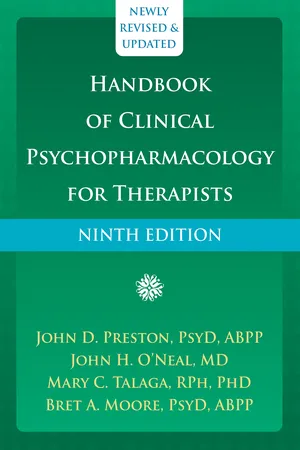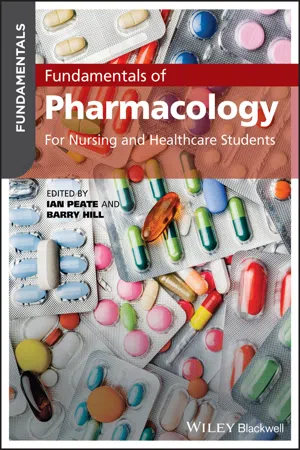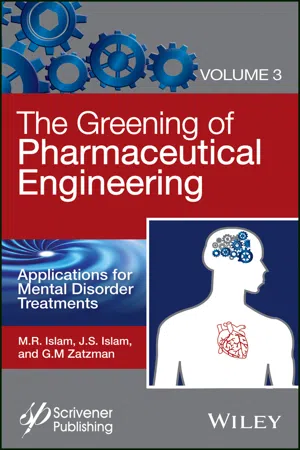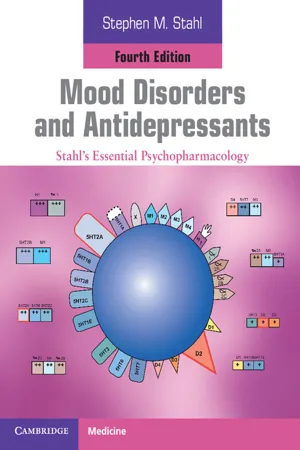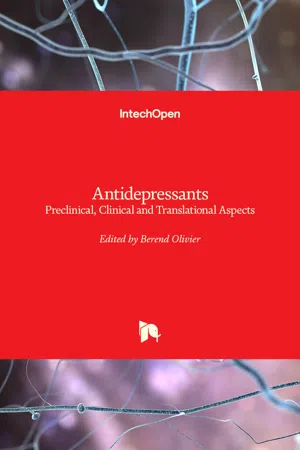Psychology
Antidepressant Medications
Antidepressant medications are a class of drugs used to treat depression and other mood disorders. They work by balancing the levels of neurotransmitters in the brain, such as serotonin and norepinephrine, which are believed to play a role in regulating mood. There are several types of antidepressants, including selective serotonin reuptake inhibitors (SSRIs), serotonin-norepinephrine reuptake inhibitors (SNRIs), and tricyclic antidepressants.
Written by Perlego with AI-assistance
Related key terms
1 of 5
10 Key excerpts on "Antidepressant Medications"
- Moore, Bret A., Talaga, Mary C., O'Neal, John H., Preston, John D.(Authors)
- 2021(Publication Date)
- New Harbinger Publications(Publisher)
Part Three Medications Part three deals with the different classes of psychopharmaceuticals, including dosage and choice of medication, side effects, and mechanism of action (where and insofar as it has been established). Also covered are precautions for monitoring medication effects and serum levels, and guidelines for educating patients and their families about the effects and side effects of these drugs. 17 Antidepressant Medications The term antidepressants refers to a large, important group of medications used to treat depression. In recent years, they have grown enormously in frequency of prescription and popularity as well as notoriety. This growth is due to increased awareness of depression and decreased troublesome side effects from the newer agents. Antidepressants were first developed in the 1950s. Iproniazid, an agent used to treat tuberculosis, was inadvertently found to produce an improvement in mood. Ultimately, it was discovered to be an inhibitor of monoamine oxidase (MAO)—an enzyme used to break down catecholamines (dopamine, norepinephrine, and sero- tonin) in neurons. This led to the development of an entire class of antidepressants: the monoamine oxidase inhibitors, or MAOIs. At about the same time, the drug imipramine was first produced. It was origi- nally developed as a phenothiazine (antipsychotic) but was found to have anti- depressant properties. Soon came amitriptyline, followed later by other “tricyclic” and “heterocyclic” antidepressants. We now have at least six major groups of antidepressants: cyclic antidepres- sants, selective serotonin reuptake inhibitors (SSRIs), serotonin and norepinephrine reuptake inhibitors (SNRIs), norepinephrine reuptake inhibitors (NRIs), monoamine oxidase inhibitors (MAOIs), and the atypicals. In addition, sometimes stimulants (such as Ritalin or Dexedrine) and atypical antipsychotics (such as Abilify and Seroquel) are used to treat depression, and there are some reports of the use of buspirone (BuSpar).- eBook - PDF
Fundamentals of Pharmacology
For Nursing and Healthcare Students
- Ian Peate, Barry Hill, Ian Peate, Barry Hill(Authors)
- 2021(Publication Date)
- Wiley-Blackwell(Publisher)
Fundamentals of Pharmacology: For Nursing and Healthcare Students , First Edition. Edited by Ian Peate and Barry Hill. © 2021 John Wiley & Sons Ltd. Published 2021 by John Wiley & Sons Ltd. Chapter 17 Aim To develop a fundamental understanding of psychotropic medication used to treat common mental health conditions. Antidepressants Depression is an affective disorder which manifests in many different ways but usually has depressed mood and/or loss of pleasure in most activities central to the presentation (NICE, 2009). The current evidence base recommends that Antidepressant Medications are used for patients whose depression is moderate–severe as evidence shows they are less effec-tive in mild cases (NICE, 2009). Psychological therapies are also useful when treating depres-sion and should be considered alongside pharmacological treatments. Selective serotonin reuptake inhibitors (SSRIs) The current evidence base recommends SSRIs as first‐line drug treatment due to their effi-cacy in treating low mood and their relatively good tolerability and side effect profile Medications used in mental health Laura Stavert Learning outcomes After reading this chapter, the reader will be able to: 1. Categorise and evaluate the different groups of medications used in psychosis, affective disorders, anxiety disorders and dementia 2. Have an understanding of the risks associated with identified drug classes 3. Have an understanding of the pharmacokinetics associated with each drug class 4. Have an understanding of the physical health monitoring necessary for identified drug classes and why this is necessary Chapter 17 Medications used in mental health 438 (Cleare et al., 2015; Joint Formulary Committee, 2019; NICE, 2009). Examples include sertra-line, citalopram and fluoxetine. - eBook - PDF
De-Medicalizing Misery
Psychiatry, Psychology and the Human Condition
- M. Rapley, J. Moncrieff, J. Dillon, M. Rapley, J. Moncrieff, J. Dillon(Authors)
- 2011(Publication Date)
- Palgrave Macmillan(Publisher)
174 13 The Myth of the Antidepressant: An Historical Analysis Joanna Moncrieff What are ‘antidepressants’ and where have they come from? Intense marketing of antidepressants over recent decades has resulted in a dramatic rise in their use, and in the widespread social acceptance of the idea that depression is caused by a ‘chemical imbalance’ that can be rectified by drugs. In 2002 eleven per cent of women and over 5 per cent of men in the United States were taking antidepressants (Stagnitti, 2005). This situation led Nikolas Rose to conclude that a large propor- tion of people have come to ‘recode their moods and their ills in terms of their brain chemicals’ (Rose, 2004: 28). Although there has been some criticism of levels of prescribing of antidepressants, and recent guidelines recommend that their use is restricted to people with more severe conditions (NICE, 2004), the idea that an antidepressant drug can reverse depression has not seriously been challenged. In this chap- ter I describe evidence that suggests that the very concept of ‘an antide- pressant’, rather than emerging from scientific data, was constructed to fulfil the pre-existing desire of the psychiatric profession, allied with the pharmaceutical industry, to present psychiatric interventions as specific treatments. At the time the concept was invented there was little evi- dence to support the idea that drugs could exert a specific ‘antidepres- sant’ action, and there remains little such evidence to this day. Certain drugs have been known as ‘antidepressants’ since the 1950s. Since that time they have been thought to act as specific treatments for depression according to what can be called a ‘disease centred’ theory of drug action (Moncrieff & Cohen, 2006). This suggests that drugs exert their effects by reversing the particular brain abnormalities that give rise to symptoms, or, in more colloquial terms, by rectifying a biochemical M. - M. R. Islam, Jaan S. Islam, Gary M. Zatzman(Authors)
- 2017(Publication Date)
- Wiley-Scrivener(Publisher)
Essentially, noth-ing is known about the mechanism of effect (the smallest particles and how they generate emotions); this is much too intangible. However, that can be said is that dopamine and serotonin are ‘hypothesized’ or ‘believed to be linked to’ depression (Tye et al ., 2013). Chemical Drugs for Mental Health Disorder 107 3.3 Antidepressants Even though it is well recognized that there is no cure for mental ailments, numerous antidepressants are available for prescription. In fact, chemical drugs are synonymous with psychiatry and go hand in hand with psycho-therapy. The following are some of the depression medications (antidepres-sants) available in the United States (a comprehensive list is available at the webMD website): Abilify (ariprazole) – used in combination with antidepressants Adapin (doxepin) Anafranil (clomipramine) Aplenzin (bupropion) Asendin (amoxapine) Aventyl HCI (nortriptyline) Celexa (citalopram) Cymbalta (duloxetine) Desyrel (trazodone) Effexor XR (venlafaxine) Emsam (selegiline) Etrafon (perphenazine and amitriptyline) Elavil (amitriptyline) Endep (amitriptyline) Fetzima (levomilnacipran) Khedezla (desvenlafaxine) Latuda (lurasidone) – an atypical antipsychotic drug used to treat bipo-lar depression Lamictal (lamotrigine) – an anticonvulsant drug sometimes used to treat or prevent bipolar depression Lexapro (escitalopram) Limbitrol (amitriptyline and chlordiazepoxide) Marplan (isocarboxazid) Nardil (phenelzine) Norpramin (desipramine) Oleptro (trazodone) Pamelor (nortriptyline) Parnate (tranylcypromine) Paxil (paroxetine) Pexeva (paroxetine) Prozac (fluoxetine) Pristiq (desvenlafaxine) Remeron (mirtazapine)- No longer available |Learn more
- (Author)
- 2014(Publication Date)
- Research World(Publisher)
________________________ WORLD TECHNOLOGIES ________________________ Chapter- 11 Antidepressant Fluoxetine (Prozac), an SSRI ________________________ WORLD TECHNOLOGIES ________________________ Venlafaxine, an SNRI An antidepressant is a psychiatric medication used to alleviate mood disorders, such as major depression and dysthymia and anxiety disorders such as social anxiety disorder. According to Gelder, Mayou &*Geddes (2005) people with a depressive illness will experience a therapeutic effect to their mood, however this will not be experienced in healthy individuals. Drugs including the monoamine oxidase inhibitors (MAOIs), tricyclic antidepressants (TCAs), tetracyclic antidepressants (TeCAs), selective serotonin reuptake inhibitors (SSRIs), and serotonin-norepinephrine reuptake inhibitors (SNRIs) are most commonly associated with the term. These medications are among those most commonly prescribed by psychiatrists and other physicians, and their effectiveness and adverse effects are the subject of many studies and competing claims. Many drugs produce an antidepressant effect, but restrictions on their use have caused controversy and off-label prescription a risk, despite claims of superior efficacy. The efficacy of modern thymoleptic anti-depressants has never been conclusively demonstrated to be greater than that of active placebo, according to two Cochrane Collaboration reviews. A review of all studies of anti-depressants ever submitted to the U.S. Food and Drug Administration (FDA), published and unpublished, was submitted to the FDA in 2004. In the published literature, anti-depressants had 94% success in treating ________________________ WORLD TECHNOLOGIES ________________________ depression. In the withheld literature, they had below 50% success. Combined, all studies showed 51% efficacy - only two points better than that of placebo. This increased the apparent efficacy of different anti-depressants from 11% to 69% over placebo. - eBook - PDF
Mood Disorders and Antidepressants
Stahl's Essential Psychopharmacology
- Stephen M. Stahl(Author)
- 2013(Publication Date)
- Cambridge University Press(Publisher)
Chapter 7 Antidepressants General principles of antidepressant action 49 Antidepressant classes 53 Selective serotonin reuptake inhibitors (SSRIs) 54 Serotonin partial agonist/reuptake inhibitors (SPARIs) 64 Serotonin–norepinephrine reuptake inhibitors (SNRIs) 66 Norepinephrine–dopamine reuptake inhibitors (NDRIs): bupropion 73 Selective norepinephrine reuptake inhibitors (NRIs) 76 Agomelatine 77 Alpha-2 antagonist actions and mirtazapine 81 Serotonin antagonist/reuptake inhibitors (SARIs) 86 Classic antidepressants: MAO inhibitors 90 Myths, misinformation, and a manual for MAOIs 95 Classic antidepressants: tricyclic antidepressants 106 Augmenting antidepressants 110 L-5-Methyltetrahydrofolate (L-methylfolate): monoamine modulator 110 S-adenosyl-methionine (SAMe) 114 Thyroid 114 Brain stimulation: creating a perfect storm in brain circuits of depressed patients 114 How to choose an antidepressant 117 Evidence-based antidepressant selections 117 Symptom-based antidepressant selections 118 Choosing an antidepressant for women based on their life cycle 121 Choosing an antidepressant on the basis of genetic testing 125 Should antidepressant combinations be the standard for treating unipolar major depressive disorder? 126 Future treatments for mood disorders 129 Summary 133 In this chapter, we will review pharmacological con- cepts underlying the use of antidepressant drugs. There are many different classes of antidepressants and dozens of individual drugs. The goal of this chapter is to acquaint the reader with current ideas about how the various antidepressants work. We will explain the mechanisms of action of these drugs by building upon general pharmacological concepts introduced in earlier chapters. We will also discuss concepts about how to use these drugs in clinical practice, including strategies for what to do if initial treatments fail and how to rationally combine one antidepressant with another, or with a modulating agent. - eBook - PDF
Antidepressants
Preclinical, Clinical and Translational Aspects
- Olivier Berend(Author)
- 2019(Publication Date)
- IntechOpen(Publisher)
1 Section 1 Introduction 3 Chapter 1 Introductory Chapter: Antidepressants - Preclinical, Clinical and Translational Aspects Berend Olivier 1. Introduction In 2011 two extensive studies were published about prevalence and associated disability, including the associated disease burden and financial costs, of brain diseases in Europe [1–3]. A shocking finding was that in a European population of more than 400 million people, approximately one-third suffered from a psy-chiatric or neurological disorder. In the psychiatric disorders, anxiety disorders had the highest 12-month prevalence (14%) and depression (7%), approximately 61.5 million people. The disability burden of psychiatric diseases including major depression is tremendous being defined in disability-adjusted life years (DALYs). In 2010, more than 26% of all cumulated disease burden in Europe was due to brain disorders; depression belongs to the top diseases with the highest DALYs. Major depression is a severe brain disorder associated with long-term disability and low quality of life. Suicide and suicidal attempts are highly associated with depression and have an enormous impact on relatives and society. 2. Antidepressants Since the 1950s and 1960s of the last century, discovery and development of antidepressants have gradually emerged. Early antidepressants like imipramine and the irreversible monoamine oxidase inhibitors (MAOI) were discovered by seren-dipity. These “accidental” discoveries have led to intensive research and have led to a series of new antidepressants, like the tricyclic class (TCA, e.g., imipramine, nortriptyline, amitriptyline, and clomipramine) and a series of (both reversible and irreversible) MAOIs. These antidepressants, although still clinically available, are not anymore first-line medicines, mainly because of their sometimes severe side effects. - eBook - PDF
- Roni Shiloh, Rafael Stryjer, Abraham Weizman, David J. Nutt(Authors)
- 2006(Publication Date)
- CRC Press(Publisher)
As a rule of thumb, all antidepressant drugs have comparable efficacy but different adverse effects profiles, although there are a few exceptions to this (e.g. selective serotonin reuptake inhibitors (SSRIs) are less efficacious in severe major depressive disorder). The antidepressants can be classified according to their mechanism of action, specifically: ● Inhibiting the transporters responsible for the uptake of monoamines (e.g. reuptake inhibition of noradrenaline and/or serotonin), leading to excessive concentration of monoamines in the synaptic cleft. ● Blockade of monoamine receptors (pre- and postsynaptic, or both). Some of these are presynaptic inhibitory auto/heteroreceptors (e.g. a 2 -adrenergic), which, when blocked, cause the presynaptic neurons to release more neurotransmitter to the synaptic cleft. Postsynaptic blockade of various receptors modulates cellular activities and is presumably responsible for the antidepressive effects. ● Inhibition of the metabolism of the mitochondrial monoamine oxidase (MAO) responsible for the degradation of approximately 30% of cytoplasmic serotonin, norepinephrine, and dopamine. By blocking MAO, the excess neurotransmitters are stored and released again upon need. 1 Notes about the scheme Antidepressants are classified as: ● Reuptake inhibitors, which include the tricyclic and tetracyclic antidepressants ( TCAs and TeCAs ),the SSRIs ( citalopram, escitalopram, fluoxetine, fluvoxamine, paroxetine, and sertraline ), the serotonin and norepinephrine reuptake inhibitors ( SNRIs ; duloxetine, milnacipran, and venlafaxine ), and the norepinephrine and dopamine reuptake inhibitor ( bupropion ). ● Receptor (both pre- and postsynaptic) blockers, which include mianserin, mirtazapine, nefazodone , and trazodone . - eBook - PDF
- Brian E. Leonard(Author)
- 2004(Publication Date)
- Wiley(Publisher)
Other international classifications of depression are based on the mono-and bipolar dichotomy, a system of classification that separates those patients with depressive symptoms only from those that fluctuate between depression and mania (i.e. manic-depression) or have only manic symptoms. In such cases treatment strategies differ as specific and antimanic drugs such as lithium or the neuroleptics would be used to abort an acute attack of mania, while antidepressants are the drugs of choice 153 Fundamentals of Psychopharmacology . Third Edition. By Brian E. Leonard 2003 John Wiley & Sons, Ltd. ISBN 0 471 52178 7 to treat the depressive episodes and anxiety associated with depression. Readers are referred to the various classification manuals, such as the Diagnostic and Statistical Manual of Mental Disorders of the American Psychiatric Association (DSM-IV) or the International Classification of Diseases , 10th Revision (ICD10), for further details. Historical development of antidepressants The use of cocaine, extracted in a crude form from the leaves of the Andean coca plant, has been used for centuries in South America to alleviate fatigue and elevate the mood. It was only relatively recently, however, that the same pharmacological effect was discovered when the amphetamines were introduced into Western medicine as anorexiants with stimulant properties. Opiates, generally as a galenical mixture, were also widely used for centuries for their mood-elevating effects throughout the world. It is not without interest that while such drugs would never now be used as antidepressants, there is evidence that most antidepressants do modulate the pain threshold, possibly via the enkephalins and endorphins. This may help to explain the use of antidepressants in the treatment of atypical pain syndromes and as an adjunct to the treatment of terminal cancer pain. Finally, alcohol in its various forms has been used to alleviate anguish and sorrow since antiquity. - eBook - PDF
- Peter M. Haddad, David J. Nutt(Authors)
- 2020(Publication Date)
- RCPsych Publications(Publisher)
As a general rule, individual antidepressants used in the treatment of MDD show little difference in efficacy (Cleare et al., 2015). Similarly, in the management of acute schizo- phrenia, antipsychotics show only minor differences in efficacy (Leucht et al., 2013). The only exception is clozapine, which has superior efficacy to other antipsychotics in treatment-resistant schizophrenia and is therefore the treatment of choice for this condition (Siskind et al., 2016). Both antidepressant and antipsychotic medications are heterogeneous in their adverse effect profiles (Cleare et al., 2015; Leucht et al., 2013). For this reason, the relative liability of medications for particular adverse effects and patients’ tolerability of side effects are often major determinants of choice of an antidepressant or antipsychotic medication (Zimmerman et al., 2004). However, individuals vary greatly in their susceptibility to and tolerance of side effects and clinical data on the relative risk of particular side effects across the medications being considered may be incomplete (Pope et al., 2010). In some cases, adverse effects may be turned to therapeutic advantage, e.g. when using a sedating antidepressant such as mirtazapine in people whose depression is associated with significant insomnia. 6.4 Acute and Long-Term Drug Treatment The pharmacological treatment of many psychiatric disorders can be divided into two phases, acute treatment and long-term treatment. However, in clinical practice the distinction between the two phases is often less than clear. Acute treatment refers to the use of medication to treat symptoms of an illness, for example an episode of depression, mania or psychosis. There is no fixed duration for acute treatment and in Chapter 6: Good Clinical Practice in Psychopharmacology 207 theory it continues until all acute symptoms have resolved; this is termed remission.
Index pages curate the most relevant extracts from our library of academic textbooks. They’ve been created using an in-house natural language model (NLM), each adding context and meaning to key research topics.
